|
a
- f | g - p | q - z
|
(The)
Quarry, Ben Russell
2002, 4:00, 16mm
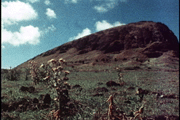
The
Quarry is a silent document of five minutes in the presence of
the sublime. This small, quiet 16mm film serves as a testament
both to cinema's failure to reproduce the lived moment and to
its success in replacing that moment with one that is equally
wondrous.
|
|
Quiproquo,
Rose Lowder (Soundtrack by Katie O'Looney)
1992, 13:00, 16mm, color/so
Situated in an environment where nature and social-industry technology
meet, the film attempts a visual dialogue with (and critique of)
mainstream society's concerns. To the extent that it refers to
the economy of means involved in relation to what is stated, the
work is both a reflection on the possibilities of the medium and
an enquiry concerning the implications of the reality filmed.
|
|
Remote
Sensing, Ursula Biemann
2001, 53:00, color
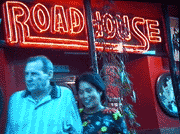
In
Biemann's latest video, she traces the routes and reasons of women
who travel across the globe for work in the sex industry. By using
the latest images from NASA satellites, the film investigates
the consequences of the U.S. military presence in South East Asia
as well as European migration politics. This video-essay takes
an earthly perspective on cross-border circuits, where women have
emerged as key actors and expertly links new geographic technologies
to the sexualization and displacement of women on a global scale.
By revealing how technologies of marginalization affect women
in their sexuality, "Remote Sensing" aspires to displace and resignify
the feminine within sexual difference and cultural representation.
http://www.wmm.com/Catalog/pages/c564.htm
http://www.wmm.com/Catalog/press/remsen_presskit.pdf
(PDF)
|
|
(The)
River, Pare Lorentz
1938, 32:00
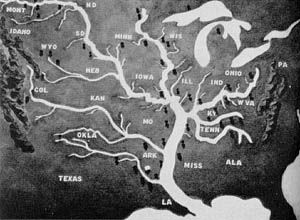
http://xroads.virginia.edu/~1930s/FILM/lorentz/front.html
http://xroads.virginia.edu/~1930s/FILM/lorentz/river.html
The
River was documentary filmmaker Pare Lorentz's masterful follow-up
to his 1936 classic The Plow That Broke the Plains. Produced on
behalf of the Tennessee Valley Authority, The River details the
history of the flood-prone Mississippi basin from prehistoric
times to the Depression era. Special attention is given the efforts
by the TVA to control floods and conserve soil in the area. Many
of the beautifully composed shots in The River--notably the distance
shots of a huge dam under construction--have become de rigeur
filmclips in subsequent film and TV documentaries of the 1930s.
The visual poetry inherent in Lorentz's images are complemented
by his free-verse narration. For a more prosaic treatment of the
same era and events, see Elia Kazan's 1960 recreation of the TVA's
1930s activities, Wild River. ~ Hal Erickson, All Movie Guide
|
|
Roam
Sweet Home, Ellen Spiro
1996, 58:00

http://www.utexas.edu/coc/rtf/faculty/spiro/films/roam.html
Inventing
freedom as they roam, videomaker Ellen Spiro and her dog Sam go
west in a vintage Airstream trailer in search of elderly dropouts
and their dogs who have pulled out of society and into by-the-side-of-the-road
trailer communities. Our mutt narrator tells his tale, sharing
his thoughts on America's smells, the foibles of humans, and his
view of aging as another journey. In unplanned meetings with gray
nomads, psychic misfits, and free spirits, Roam Sweet Home takes
the myths of growing older and turns them on their head. The director
and her dog join an adventurous and spirited community of roamers
and loners on wheels who live by the road full-time. Major funding
for this program was provided by the Corporation for Public Broadcasting
through the Independent Television Service and Channel 4, London.
Courtesy
of Video Data Bank
|
|
Seated
Figures, Michael Snow
1988, 50:00, 16mm, color/so
"In
SEATED FIGURES ... Michael Snow again explores the ground zero
of motion pictures - this time literally. Most simply described,
the film ... is a 40-minute consideration of a landscape from
the perspective of an exhaust pipe. The artist appears to have
bolted his camera, lens down, to a metal arm extending off the
back of a truck ... then driven over asphalt and dirt roads, out
to the beach, along a riverbed, and through a field of daisies.
Although hypnotic, the movement is not continuous. The vehicle
stops, reverses direction, then accelerates to produce a diagonally
striated forcefield.
"For
all his conceptual sophistication, Snow subscribes to a casual,
all-encompassing Cage aesthetic. He's deceptively artless, a master
of the visual deadpan. While trafficking in geological abstraction,
he arrests the film's frantic motion, freezing some blurry onrush
or a frame of flowing water. A soundtrack of coughs, yawns, and
humming projector creates a further displacement. The images are
distanced - accompanied by the muffled noises of an audience watching
a movie. Hence the mysteriously inert title. SEATED FIGURES is
about its audience. Not only are we sent flying face down over
the earth, but Snow reverses the oldest concept in image-making
- he juxtaposes our seated, static figures against a constantly
moving ground." - J. Hoberman, The Village Voice
|
|
(The)
Secret History of the Dividing Line, David Gatten
USA, 20:00, 16mm
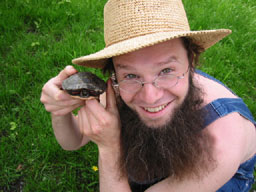
Conflicting
descriptions of the same territory by the same William Byrd fracture
in an attempt to inhabit the same space, yielding to obscure landscapes
that vividly depict the numerical distances relegated to an appendix.
As subtly rhythmic and droll as it is outwardly austere, David
Gatten's continued perusal of the Byrd library generously rewards
patience with its faithful curiosity. -- Spencer Parsons
|
|
Seven
Days, Chris Welsby
1974, 20:00, 16mm, color/so

The location for this film is by a small stream on the northern
slopes of Mount Carningly in southwest Wales. The seven days were
shot consecutively and appear in that same order. One frame was
taken every ten seconds throughout the hours of the day. The camera,
mounted on an equatorial stand (a piece of equipment used by astronomers
to track the stars), rotates at the same speed as the earth.
"The
Romantic cult of nature, which made it possible for landscape
painting to flourish in the nineteenth century more than ever
before, grew up alongside and in reaction against the technological
destruction of nature which accompanied the industrial revolution.
The danger, of course, was that our culture would simply become
increasingly split, as art set itself up against science, and
science was applied and developed, divorced from any concern over
value. Welsby's work makes it possible to envisage a different
kind of relationship between science and art, in which observation
is separated from surveillance and technology from domination.
The late development of landscape art means that its particular
history may only now be really beginning, as it enters a new post-painterly
phase." - Peter Wollen
|
|
Sky
Light, Chris Welsby
1988, 26:00, 16mm, color/so
An idyllic river flows through a forest, flashes of light and
colour threaten to erase the image, bursts of short wave radio
and static invade the tranquility of the natural sound.
The camera searches amongst the craggy rocks and ruined buildings
of a bleak and windswept snowscape, a Geiger counter chatters
ominously in the background.
The sky is overcast at first but gradually clears to reveal a
sky of unnatural cobalt blue ....
Made in three sections, the film resembles a search for meaning
amongst a plethora of electronic, chemical and mechanistic information.
SKY LIGHT was made in response to some very strong feelings experienced
at the time of the Chernobyl disaster in 1986.
|
|
(The)
Sky On Location, Babette Mangolte
1982, 77:15, 16mm, color, sound
Light
is a narrative device--it gives you time and it defines space.
In the succession of shots, changes of color imply time.
"The
landscape is not seen in its postcardish grandeur as in Ansel
Adams, nor through its shapes as in Cezanne or in Constable, but
rather the film captures the mood of the landscape as in a Turner
painting. The film attempts to construct a geography of the land
from North to South, East to West, and season to season through
colors instead of maps."
"From
the beginning the film (The Sky) was meant to be without any people
at all. But after I saw the footage from the summer, I said, 'That's
unbearable; I need once or twice to have an element of scale.'
Because everything appeared to be at the same distance. Whether
you use a telephoto shot of a mountain or a wide angle shot, you're
always very far from the mountain, if you see it at all ... The
space is so open that there is never any foreground to give you
perspective. That's what fascinated me in the subject matter ...
geography made visible through color and light. I discovered that
the light shifts so radically that a certain element of drama
is possible."
"The
Sky is not about nature as backdrop, but more about the idea of
wilderness, which I've discovered is so ingrained in American
culture, but totally bewildering for Europeans. I don't even know
a French word you could use to translate the idea. I am Americanized
enough now to identify with it. Traveling alone, or with one assistant,
through those places helped me understand. Europe lost the sense
of wilderness centuries ago. It's so much more crowded per square
mile. There is no area which is not put to some use, and which
is not crossed by many roads. Even the tops of the mountains are
not really secluded. And you don't have that sense of space...."
http://visarts.ucsd.edu/faculty/bmangolt.htm
|
|
Stranger
With A Camera, Elizabeth Barret
2000, 58:40
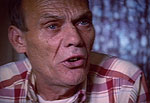
http://www.appalshop.org/stranger/
http://www.appalshop.org/film/film.php?filmid=84
http://www.appalshop.org/headwaters/episode_209.htm
http://www.itvs.org/strangerwithacamera/index.html
http://www.pbs.org/pov/pov2000/strangerwithacamera/
In
1967 Canadian filmmaker Hugh O'Connor visited the mountains of
Central Appalachia to document poverty. A local landlord, who
resented the presence of filmmakers on his property, shot and
killed O'Connor, in part because of his anger over the media images
of Appalachia that had become icons in the nation's War on Poverty.
Filmmaker Elizabeth Barret, a native of Appalachia, uses O'Connor's
death as a lens to explore the complex relationship between those
who make films to promote social change and the people whose lives
are represented in such media depictions. Through first-person
accounts of the killing and the perspective of three decades of
reflection, Stranger With A Camera leads viewers on a quest for
understanding - a quest that ultimately leads Barret to examine
her own role as both a maker of media and a member of the Appalachian
community she portrays.
"A
provocative moral inquiry but also a vivid portrait of a place
and time." - The New York Times
|
|
Stream
Line, Chris Welsby
1976, 8:00, 16mm, color/so

This film was made on Mount Kinderscout in Derbyshire, England.
It is a continuous, "real time" tracking shot of a stream bed.
The length of the track was ten yards. The camera was suspended
in a motorized carriage running on steel cables three feet above
the water surface. The camera pointed vertically downwards recording
the contours of the stream bed and the flow of water along its
course. The sound of the water was recorded synchronously from
the moving carriage.
The "drama" in this film comes from the topography of the stream
and not from the camera motion or from the editing. Throughout
the unedited length of the film, the camera tracks along a straight
line at an absolutely regular speed. In contrast the stream runs
fast and slow, cascading over boulders and swirling turbulently
from left to right.
... I think of the straight line formed by the tracking device
as a metaphor for technology ... used [in this model] as a means
to articulate the complexity of nature. ...When the film is projected
the viewer becomes aware of this line through the passing of time;
in STREAM LINE space is represented through duration.
|
|
Suicide
Box, Bureau of Inverse Technology
1996, 13:00

http://www.vdb.org/smackn.acgi$tapedetail?SUICIDEBOX
http://www.bureauit.org/bitindex.html
A
documentary video about the B.I.T. Suicide Box--a motion-triggered
camera developed by the Bureau of Inverse Technology (a private
information agency), and installed within range of the Golden
Gate Bridge to capture a video record of anything that falls from
the bridge, and provide an accurate measure of the suicide rate.
The tape points to confusing roles for technology within contemporary
culture. --Whitney Biennial Exhibition, 1997
|
|
Suggested
Photo Spots, Malinda Stone & Igor Vamos
1997, 10:00

http://www.clui.org/clui_4_1/pro_pro/extrap/proj/phospo/photosp1.html
http://www.clui.org/clui_4_1/pro_pro/extrap/proj/phospo/photo2.html
Media
Artists Melinda Stone and Igor Vamos initiated and executed the
Photo Spot Project for The Center, installing over 50 "Suggested
Photo Spot" signs at selected sites from coast to coast.
Sights designated as a "Suggested Photo Spot" include
the tailings pile of a copper mine and the waste water treatment
facility for the Kodak company's headquarters. But the spots are
not selected simply according to the function of facilities or
land uses at the site. The criteria for selecting the Spots primarily
relate to tourist photography issues, based on visual and aesthetics
considerations, and a sense of what might be "photogenic".
"In most cases, you have to be there to fully get it",
says Stone, "the pictures we take of the Photo Spots represent
just one aspect of the site, but the project is really about the
interaction of viewers with each location".
Courtesy
of Video Data Bank
|
|
Terra
Incognita, Ben Russell
2002, 10:00, 16mm
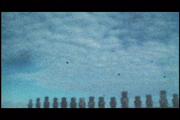
Terra
Incognita is a lensless film whose cloudy pinhole images create
a memory of history. Texts from ancient and modern explorers about
Easter Island are garbled together by a computer narrator, resulting
in a forever repeating narrative of discovery, colonialism, loss
and departure.
|
|
There
There Square, Jacqueline Goss
2002, 14:00

The
desire to own and name land and the pleasures of seeing from a
distance color this personal survey of the history of mapmaking
in the New World.
There There Square takes a close look at the gestures of travelers,
mapmakers, and saboteurs that determine how we read - and live
within- the lines that define the United States.
http://www.vdb.org/smackn.acgi$tapedetail?THERETHERE
...My
own greatest pleasure at the Festival came with another short
film, There There Square, shown in the "Almost Paradise" collection.
Directed by Jacqueline Goss, it evokes a child's computerized
geography lesson. A map of the United States, white on a solid
blue background, forms the central image of the film; as words
onscreen muse about the connections between history, geography,
and the personal, the map morphs into a myriad of shapes, like
the varied answers supplied by children and adults asked to "draw
a map of the United States."
Completely
silent, There There Square allows for reflection and for reading
between the histories of mapmakers, presidents, and explorers
to find where the actual and imagined borders of the United States
lie. Inevitably, they are more defined by personal than collective
histories. We love looking from above, Goss suggests, because
it makes us feel like we own everything in view, from stories
to territories. But, There There Square proposes, we base our
presumptions on individual experiences, losing sight of broader
concerns and realities. This is a child's first geography lesson,
beautifully articulated by Goss' subtle direction.
http://www.popmatters.com/film/features/030320-nyuff-2003.shtml
|
|
This
is Nowhere, Doug Hawes-Davis
2002, 87:00, color
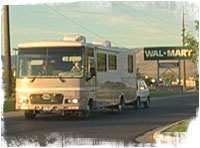
http://www.highplainsfilms.org/fp_nowhere.html
Each
year tens of thousands of travelers steer their RVs into Wal-Mart
parking lots to "camp" for a night or two. Not because they have
to. Rather, because they want to. Just as they seek out national
parks and historic sites, RV travelers have marked Wal-Mart stores
as travel destinations. Full of irony, This is Nowhere humorously
captures the essence of American attitudes toward nature, equality,
and civic values as it documents RV travelers' interactions with
landscape, technology, communities, and each other.
"The
film allows the RV-ers...to speak for themselves, and the result
is...sometimes hilarious, sometimes disturbing commentary about
contemporary American values." Read
full review from Mother Jones
|
|
Troublesome
Creek: A Midwestern, Jeanne Jordan and Steven Asher
1995, 88:00, color
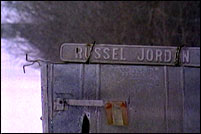
http://www.pbs.org/wgbh/amex/trouble/
"I
was raised on Westerns. Red River, High Noon, Gunsmoke--where
the bad guys sometimes won but never prevailed. Our film is a
Midwestern. It's the story of my family's farm in Iowa: From crossing
the Mississippi by covered wagon in 1867 to driving to Daddy Date
Night in 1967. From my great-grandfather fighting off the Crooked
Creek Gang in the 1880's to my father fighting off foreclosure
in the 1990's." --Filmmaker Jeanne Jordan
In the spring of 1990, Jeanne Jordan's father Russel called Jeanne
and her husband, Steven Ascher, in Boston and announced that he
might very well be facing his last year of farming. Jeanne and
Steven were in shock.
The farm that Russel and Mary Jane Jordan worked and lived on
had been in the family for 125 years. It had survived the dust
bowl, the Depression, two world wars, and the economically turbulent
1980's. Now Russel and Mary Jane were doing all they could simply
to stave off foreclosure.
In Troublesome Creek: A Midwestern, filmmakers Jeanne Jordan and
Steven Ascher return to the Jordan family farm in Iowa, where
a new regional bank has decided to call in an accumulated $70,000
debt, forcing the family into some difficult decision making.
During these days of soul searching and discussion, Jordan and
Ascher filmed life on the farm as it took place. There was no
script. There were no re-enactments.
Though Troublesome Creek: A Midwestern is a deeply personal film,
narrated with effective understatement by daughter and filmmaker
Jeanne Jordan, the story it tells is universal. It is a story
of passages, and the undeniable sweep of changing times. It is
also a story of how family and community ties can be maintained,
and even strengthened, during the most trying of times.
Troublesome Creek: A Midwestern was nominated for an Academy Award
and was awarded both the Grand Jury Award and the Audience Award
for best documentary at the Sundance Film Festival.
|
|
Tununeremiut:
The People of Tununak, Sarah Elder, Leonard Kamerling
1972, 35:00
Four
sequences, filmed over a two-month period, portray aspects of
the lives of the people of Tununak, a village on the south-western
coast of Alaska. In the first, the villagers evacuate their homes
and camp on higher ground, fearing that a Nuclear test on Amchitka
Island, 1000 miles away, may cause a tidal wave. In a quietly
ironic scene, the Eskimos listen to the countdown on their radios,
wondering if this modern blast will bring forth an ancient disaster.
In the second vignette, a group of men travel by snowmobile to
place fishtraps under the river ice. They become lost in heavy
fog, blinded by the glare of the ice, and confused by the complicated
turns of the rivers in a landscape where the only landmarks are
short, low-lying bushes or old fishtraps. In spite of the difficulty
of seeing, they discus their quandary calmly and eventually find
their way.
A sudden storm from the Bering sea hits Tununak with gale force
winds and heavy snow. Laundry blows wildly in the wind as people
prepare for the storm.
The concluding sequence captures communal warmth as people gather
in the meeting hall for traditional story-dancing. All participate:
men beating drums, and singing, women dancing, adorned with beaded
headbands and feathery finger masks. The dancing in Tununak still
provides an important outlet for individual expression, at the
same time communicating the village's unwritten history.
|
|
Undeniable
Evidence, Igor Vamos
1995, 30:00

A
provocative half-hour of guerrilla artists caught in the act on
videotape, Undeniable Evidence is a public art extravaganza assembled
by Igor Vamos and anonymous culture jammers.
Ephemeral pieces documented include Grupo Baja Mar/The Low Tide
Group. An artists' group uses the unique geologic and architectural
features of Spain's San Sebastian's beaches to create a giant
public billboard that wipes itself clean each day with the incoming
tide. In English and Spanish.
Human Target Flag Responding To Operation Desert Storm. A Portland,
Oregon group hangs an enormous U.S. flag, composed of human silhouette
targets, off a bridge directly in front of U.S. Navy ships during
war homecoming celebrations.
Reverse Peristalsis Painting. Outside Vice President Dan Quayle's
fundraising brunch for Bob Packwood, an organized group of 24
people in ill-fitting suits engage in the event by vomiting the
colors of the American flag.
Malcom X Street. At a time when the city of Portland is considering
stripping Martin Luther King Jr.'s name off a local street, a
covert organization calling itself Group X changes the name of
another downtown street to Malcolm X Street in a clandestine overnight
action.
Canine Edible Sculpture. After overcoming their initial fear,
fifteen dogs consume a sculpture made of 480 pounds of grisly
beef bones and dry dog food on a football field.
|
|
Vernon,
Florida, Errol Morris
1982, 72:00
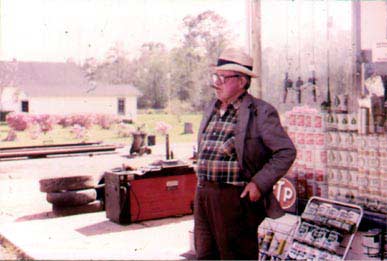
"Vernon,
Florida" is an odd-ball survey of the inhabitants of a remote
swamp-town in the Florida panhandle. Henry Shipes, Albert Bitterling,
Roscoe Collins and others discuss turkey-hunting, gator-grunting
and the meaning of life. This second effort by Errol Morris, originally
titled "Nub City," was about the inhabitants of a small Florida
town who lop off their limbs for insurance money ("They literally
became a fraction of themselves to become whole financially,"
Morris commented.) but had to be retooled when his subjects threatened
to murder him. Forced to come up with a new concept Morris created
"Vernon, Florida" (1981) about the eccentric residents of a Southern
swamp town.
David Ansen in Newsweek wrote, "Errol Morris makes films unlike
any other filmmaker. 'Vernon, Florida', like his earlier study
of pet cemeteries, 'Gates of Heaven', is the work of a true original.
On the surface, it is simply a portrait of several somewhat eccentric
residents of a slow backwater town... There's a taste of Samuel
Beckett in the film's tone of droll, forlorn hopefulness, and
something of Buster Keaton in the spacious frames and exquisitely
deadpan comic timing. 'Vernon, Florida' isn't sociology at all,
it's philosophical slapstick, a film as odd and mysterious as
its subjects, and quite unforgettable."
http://errolmorris.com/main.php
|
|
Walden
(aka Diaries, Notes & Sketches), Jonas Mekas
1964-8/1968-9, 175:00
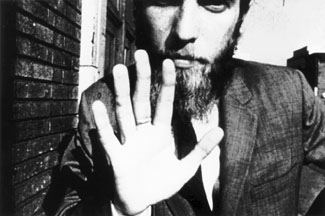
http://www.sensesofcinema.com/contents/01/17/mekas_interview.html
"Since
1950 I have been keeping a film diary. I have been walking around
with my Bolex and reacting to the immediate reality: situations,
friends, New York, seasons of the year. On some days I shot ten
frames, on others ten seconds, still on others ten minutes. Or
I shot nothing. When one writes diaries, it's a retrospective
process: you sit down, you look back at your day, and you write
it all down. To keep a film (camera) diary, is to react (with
your camera) immediately, now, this instant: either you get it
now, or you don't get it at all. To go back and shoot it later,
it would mean restaging, be it events or feelings. To get it now,
as it happens, demands the total mastery of one's tools ( in this
case, Bolex): it has to register the reality to which I react
and also it has to register my state of feeling (and all the memories)
as I react. Which also means, that I had to do all the structuring
(editing) right there, during the shooting, in the camera. All
footage that you'll see in the Diaries is exactly as it came out
from the camera: there was no way of achieving it in the editing
room without destroying its form and content.
Walden contains materials from the years 1965-69, strung together
in chronological order. For the soundtrack I used some of the
sounds that I collected during the same period: voices, subways,
much street noise, bits of Chopin (I am a romantic), and other
significant and insignificant sounds."
"They
tell me, I should always be searching; but I'm only celebrating
what I see." (Jonas Mekas)
"I
make home movies -- therefore I live. I live -- therefore I make
home movies." (Jonas Mekas)
WALDEN: REEL ONE "New York in Spring; Tony Conrad; Bibbie in Central
Park; a Wedding; Breakfast in Marseilles; Cassis; Sitney leaves
New Haven; Fire on 87th Street; Brakhage crosses Central Park;
Carl Th. Dreyer; a Trip to Millbrook; Flowers for Marie Menken;
Gregory Markopoulos shoots Galaxie; Notes on the Circus."
WALDEN: REEL TWO "Kreeping Kreplachs meet (Ginsberg, Ed Sanders,
Tuli, Warhol, Barbara Rubin, etc.)/Hare Krishna walk; autumn scenes;
Sitney's Wedding; New Year's Evening in Times Square; Goofing
on 42nd Street; Uptown Party; Velvet Underground; Deep of Winter;
Naomi visits Ken & Flo Jacobs; Amy stops for Coffee; Coop Directors
meet; Dreams of Cocteau; In Central Park; What Leslie saw through
the Coop window; Olmsted Hike"
WALDEN: REEL THREE "Barbara Rubin shoots a movie; Christmas Eve;
A visit to Brakhages (Colorado); a visit to Hans Richter; in Central
Park; Peter's Wedding."
WALDEN: REEL FOUR "Autumn scenes; Mel's children; a trip to New
Jersey; Wendy's Wedding; in Central Park; Skating rink; Winter
scenes; Sunday Morning Snowstorm on 8th Avenue; Martha; Anthology
Cinema meets; Yoko Ono & John Lennon; Central Park."
|
|
Water
and Power, Pat O'Neill
1989, 57:00, 35mm
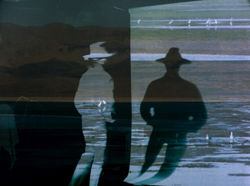
http://www.ufvc.org/recentshows/033100ONeill/ONEILL2.htm
http://mfj-online.org/journalPages/MFJ30,31/DJamesInterview.html
|
|
Weather
Diary 1, George Kuchar
1986, 1:21:00

http://www.cabinetmagazine.org/issues/3/stormsquatting.php
This
feature-length tape documents one month in a trailer park/motel
in Oklahoma, following passing weather systems and the parade
of people passing by.
"The
tape ultimately addresses all the big questions--death, origin
and family, religion--as well as the small discomforts of the body,
only to reverse their order of importance." --Margaret Morse, Framework,
Los Angeles Contemporary Exhibitions
|
|
Weather
Diary 2, George Kuchar
1987, 1:10:00
In a motel in El Reno, Oklahoma, George observes the weather and
copes with leaking air conditioning, food shopping, loneliness,
television, and eating, among other things.
|
|
What
the Water Said, Nos. 1-3, David Gatten
1997-98, 16:00
These films are the result of a series of camera-less collaborations
between the filmmaker, the Atlantic Ocean and its underwater inhabitants.
For three days in January and three days in October of 1997, and
again, for a day, in August of 1998, lengths of unexposed, undeveloped
film were soaked in a crab trap on a South Carolina beach. Both
the sound and image in WHAT THE WATER SAID are the result of the
ensuing oceanic inscriptions written directly into the emulsion
of the film as it was buffeted by the salt water, sand and rocks;
as it was chewed and eaten by the crabs, fish and underwater creatures.
|
|
Why
Live Here?, Mark Street
1996, 60:00, color, 16mm

Why
Live Here? explores three characters' reaction to their environments--
San Francisco, Florida and Montana. In the film each character
develops a particular relationship to place. One moves back to
Montana to help with a family business, another moves to SF for
the cultural climate, and a third moves to Tampa, Florida for
a temporary job. All wonder why they are where they are, and what
they might be missing elsewhere. Through the musings of the three
characters, the film considers notions of home and community in
an age when people move all over for all reasons.
http://www.hi-beam.net/mkr/ms/ms-bio.html
http://art.umbc.edu/fac_staff/street.htm
|
|
Windmill
2, Chris Welsby
1972, 8:00, 16mm, color/si

This film is one of a series of films (Wind Vane, Anemometer,
Tree, Park, Estuary etc.) which uses an element present within
the frame as a feedback device to control an aspect of the recording
process. In this case it is the wind moving the leaves on the
trees within the frame which also causes the windmill to rotate
like a secondary shutter in front of the camera. This rotation
of the mirrored windmill blades causes the image on the screen
to alternate between the space in front of the camera, seen intermittently
through the blades, and the space behind the camera, reflected
in the blades. When the windmill reaches a particular speed, a
third space is also created as the deep space of the picture plane
fragments and becomes a two dimensional abstract surface of colour
and light.
|
a
- f | g - p | q - z
|























